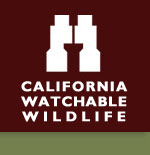

| Visitation: 400,000 | ||
| Area: 131,983 Acres | ||
| Lat: 41.213179 | ||
| Lon: 124.004628 | ||
| Nearby Services | ||
| Site Facilities | ||
| Join Our Mailing List |
|
For Email Marketing you can trust
|
Top Banner Photo Credits
Pam Starr
Alyn Robert Brereton
Julie MacKinnon
Linda Pittman
Parham Pourahmad
Larry Whiting
Randall Finley
Pam Starr
Alyn Robert Brereton
Julie MacKinnon
Linda Pittman
Parham Pourahmad
Larry Whiting
Randall Finley
© 2008-2024 California Watchable Wildlife and Blue Cat Studio, Inc.
| Redwood National and State Parks - Site # 175 | |||
| Prairie Creek Redwoods, Del Norte Coast and Jedediah Smith State Parks and Redwood National Park are managed cooperatively by the National Park Service and the California Department of Parks and Recreation. These parks make up 45 percent of all the old-growth redwood forest remaining in California. | |||
 | Premium - the most significant sites, worth visiting if you have limited time. Premium sites have high wildlife values year-round, staff on site, interpretive programs and/or displays, and well-developed facilities. | ||

| |||
| Background: | This wildlife paradise covers 37 miles of coastline, inland streams, hills, and groves of coastal redwoods, the world's tallest trees, and California's state tree. Sea lions and humpback and California gray whales appear offshore, cormorants, common murres, and other marine birds roost on coastal rocks. Low tides expose tidepools beneath sheer cliffs. Cinnamon teal, common mergansers, and other waterfowl gather at river estuaries, where shorebirds inhabit the tidal flats. Inland, streamside vegetation and mature forests ustain many songbirds. Oak woodlands are interspersed with priaires that attract Roosevelt elk, black-tailed deer, coyotes, and birds of prey. Black bears and small mammals seek the forest's cover. Rhododendrons and wilflowers bloom in late spring. Watch for bald eagles, peregrine falcons,osprey, and brown pelicans. | ||
| Yurok Tribal Culture, Logging Industry, and Redwood ecosytem recovery. | |||
| The Experience: | International Man in the Biosphere Reserve and and World Heritage Site due to old growth Coastal Redwoods and Coastline. | ||
| Wildlife and Where to Find It: | A wide range of opportunities that mostly warrant a car. | ||
| Viewing Tips: | More than 300 bird species, about half are water-assoceated. Nearly 100 mammal and fifteen salamander species. High probability of seeing waterfowl in winter, songbirds and wading birds in spring and summer. Marbled murrelets and spotted owls found in old-growth forest. Marine mammals, sea birds, shorebirds, and birds of prey can be seen year-round. Good chance of seeing Roosevelt elk and black bears during summer. | ||
| Site Notes: | Park access points begin 50 miles north of Eureka and continue northwards to Crescent City. Best Season to View: Spring through late Fall, with good year-round viewing. Some coastal fog in summer and heavy precipitation in winter. | ||
| Nearby Viewing Sites: | Smith River National Recreation Area Tolowa Dunes State Park Harbor and breakwater in Crescent City California Coastal National Monument | ||
| Festivals & Events: | Godwit Days in the spring - Humboldt County | ||
| Visitor Information: | Del Norte Chamber and Visitors Buearu or Humboldt Countu Visitor - 707-464-3174 or 707-443-5097 - https://visitdelnortecounty.com or https://visithumboldt.com/ | ||
| Viewing Site Hours of Operation are: | |||
| Staff On-site: | Yes | ||
| Open: | Everday | ||
| Hours: | 24 hours | ||
| Year Round: | Yes | ||
| Road Information: | |||
| Road Hazards: High winds in winter storm with resulting debris from tree canopy | |||
| Parking Fee: No | |||
| Proximity to viewing area: | |||
| Parking Danger: Logging trucks, fog, storms, narrow roads in some locations | |||
| How to Get There: | Park headquarters located in Crescent City. Highway 101 runs through park between Crescent City and Orick. Many well-marked access points. | ||
| Contact Information | |||
| Managing Agency: | National Park Service | ||
| Agency Site URL: | www.nps.gov/redw | ||
| Physical Address: | 1111 Second Street Crescent City, CA 95531 |
Agency 2: | 1111 Second Street Crescent City, CA 95531 |
| Manager Phone: | (707) 465-6301 | Contact Us: | by Email |
| Site Phone: | (707) 44-6101 | ||
| County: | Humboldt and Del Norte | ||
| Addition Website: | |||
